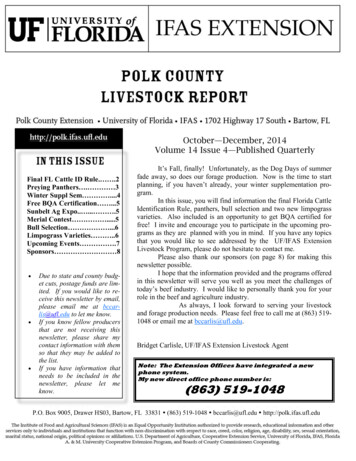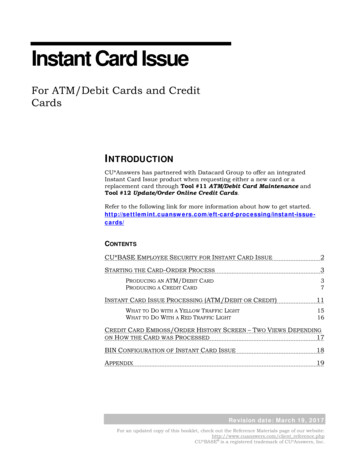
Transcription
October—December, 2014Volume 14 Issue 4—Published QuarterlyFinal FL Cattle ID Rule. .2Preying Panthers . 3Winter Suppl Sem .4Free BQA Certification .5Sunbelt Ag Expo. . .5Merial Contest .5Bull Selection .6Limpograss Varieties .6Upcoming Events .7Sponsors 8 Due to state and county budget cuts, postage funds are limited. If you would like to receive this newsletter by email,please email me at bccarlis@ufl.edu to let me know.If you know fellow producersthat are not receiving thisnewsletter, please share mycontact information with themso that they may be added tothe list.If you have information thatneeds to be included in thenewsletter, please let meknow.It’s Fall, finally! Unfortunately, as the Dog Days of summerfade away, so does our forage production. Now is the time to startplanning, if you haven’t already, your winter supplementation program.In this issue, you will find information the final Florida CattleIdentification Rule, panthers, bull selection and two new limpograssvarieties. Also included is an opportunity to get BQA certified forfree! I invite and encourage you to participate in the upcoming programs as they are planned with you in mind. If you have any topicsthat you would like to see addressed by the UF/IFAS ExtensionLivestock Program, please do not hesitate to contact me.Please also thank our sponsors (on page 8) for making thisnewsletter possible.I hope that the information provided and the programs offeredin this newsletter will serve you well as you meet the challenges oftoday’s beef industry. I would like to personally thank you for yourrole in the beef and agriculture industry.As always, I look forward to serving your livestockand forage production needs. Please feel free to call me at (863) 5191048 or email me at bccarlis@ufl.edu.Bridget Carlisle, UF/IFAS Extension Livestock AgentNote: The Extension Offices have integrated a newphone system.My new direct office phone number is:(863) 519-1048P.O. Box 9005, Drawer HS03, Bartow, FL 33831 (863) 519-1048 bccarlis@ufl.edu http://polk.ifas.ufl.edu
Polk County Livestock Report2Final Florida Cattle Identification Rule—Effective 9/4/14The Cattle IdentificationRule (Chapter 5C-31, Florida Administrative Code) hasbeen published with an effective date of September 4,2014. This rule is intendedto improve our ability to respond to serious disease outbreaks and to help the industry maintain out-of-statemarkets. The rule will require cattle 18 months of ageor older moving within thestate to be tagged with Official Individual Identification. Cattle moving to Approved Tagging Sites fortagging, cattle moving directly to slaughter, and cattlemoving between pasturesunder normal ranching operations, without changingownership, are exemptedunder the rule.Cattle owners can apply Official Identification Tagsthemselves or have their cattle tagged at an ApprovedTagging Site. A variety ofOfficial Identification Tagscan be purchased through ananimal health product supplier or USDA, NationalUniform Eartagging System(NUES) tags can be obtained, at no charge, throughthe Division of Animal Industry by calling 850-4100900 or by contacting thelocal district office. A list ofour district offices and Approved Tagging Sites isavailable at the Florida Cattle Identification Web pageon the Division of AnimalIndustry’s Website, AnimalIndustry.The Department will providea 60-day period of continuededucation and outreach priorto commencing enforcementactions on November 4,2014. During this 60-dayeducational period, the Department will offer trainingsessions at livestock marketsand producer meetings, distribute summary informationat the Agricultural Interdiction Stations, and provideaccess to a PowerPointpresentation with audio onour Website. Once enforcement begins in November,eligible cattle moving withinthe state must be OfficiallyIdentified or the cattle willbe quarantined until the rulerequirements are met. Subsequent violations will resultin quarantine and administrative fines.This rule has been discussedfor a number of years in over60 public meetings with ourcattle industry, and producers and markets are nowworking to prepare themselves to fully comply withthe identification requirements.For more information aboutpremises registration, official tags, or Approved Tagging Sites, please contactStephen Monroe, ProgramManager, at (850) 410-0944.
Polk County Livestock Report3Panthers prey on ranchers' calves, but how much variesUFNews—GAINESVILLE, Fla—A two-year panther study at twosouthwest Florida cattle ranchesshows that the endangered catsattack and kill calves, but how often that happens can vary greatlyby location and landscape.Caitlin Jacobs, a University ofFlorida master’s student in wildlifeecology and conservation, conducted the study, in which radiotransmitter tags were put on theears of 409 calves at two ranches,both near Immokalee.The Florida panther nearly diedout, with an estimated populationthinning to just 20 to 25 panthersby 1995, with conservation effortshelping the cat’s numbers grow toan estimated 100 to 160 by 2012.But the panthers’ comeback hasnot always been helpful to cattleranchers.One of the ranches Jacobs studiedlost 10 calves, or 5 percent of theherd each year, to preying panthers, while the other lost onlyone, or half a percent of that herd,during the same time span. Bothranches also lost calves to othercauses, including eight deaths atone ranch and five at the other notattributed to predators.Overall, panther attacks caused themost deaths, although panthersweren’t the only predator forcalves to contend with. Each ranchalso lost at least one ear-taggedcalf to a bear attack during the two-year study, while some untaggedcalves were killed by coyotes andvultures.The ranches’ physical geography,including open spaces and theproximity of wooded areas inwhich the cats can hide and stalk,likely have much to do with thedifferent rates, she said. But forthe panthers to continue theircomeback, they rely greatly on themixed landscape found on ranches, which includes forests, wetlands, prairies and pastures.Jacobs said she hopes her researchhelps lead to fruitful policy discussion between state conservationofficials and ranchers, perhaps toprograms that might pay ranchersto maintain key panther habitat,rather than as compensation fordifficult-to-track individual calflosses.“The ranching landscape is important for panthers. Land that’sused for housing or row crops orcitrus groves doesn’t help them thesame way; they need those naturalareas,” she said.The research was often gory, withJacobs, multi-county UF/IFASlivestock Extension agent LindseyWiggins and the ranchers themselves evaluating scenes and playing sleuth to determine whichpredator was to blame: panthers,coyotes, bears or even vultures.A bite wound to the front or backof the calf’s neck was most oftenthe mark of a panther attack, shesaid, and the cats almost alwaysdragged their prey to a hiding spotnearby to revisit later. Coyote andbear attacks were much more damaging, with the calf’s body badlybruised or found to have many external wounds.Jacobs presented her research twoweeks ago at the North AmericaCongress for Conservation Biology in Missoula, Mont. MartyMain, associate dean for extensionfor UF’s Institute of Food and Agricultural Sciences, supervised herresearch. They expect the study tobe published later this year.The study was funded by the U.S.Fish and Wildlife Service, theFlorida Fish and Wildlife Conservation Commission, Defenders ofWildlife and supported by JBRanch and Immokalee Ranch,where Jacobs did her research.
Polk County Livestock ReportOctober 21, 20145:30PM4
Polk County Livestock ReportGet BQA Certified .for Free!For the third time, BoehringerIngelheim Vetmedica, Inc. (BIVI)is supporting the checkoff-fundedBeef Quality Assurance (BQA)program by sponsoring all onlinecertifications this fall for producerswho enroll from September 1 - October 31.Boehringer Ingelheim Vetmedica,Inc. BIVI will pick up the 25- 50certification fee for beef or dairyproducers who are interested inbecoming certified or www.animalcaretraining.org. Usecoupon code BIVIBQA.52014 Sunbelt Ag ExpoOctober 14-15, 8:30am—5pmOctober 16, 8:30am - 4pmMoultrie, GA Hwy. 133Free Parking - 10 peradult ( 20 for three daypass)Children under 10 freewhen accompanied by adultOne of the many exhibits that producers and consumerslook forward to every year is the Beef Cattle exhibits anddemonstrations. These demos will be held in the Bill PattenLivestock Pavilion located in block E-8 of the exhibitgrounds. Steve Blackburn shares a passion with farmers andranchers by offering the best health and well being to beefcattle as possible. This is accomplished by staying currenton the latest issues, remedies, market trends, and care techniques in the beef cattle industry. The presentations willgive cattle producers and consumers the perfect opportunityto gain the knowledge needed for proper care of beef cattleacross the nation.For more information visit sunbeltexpo.com. or call 229890-5425.2014 Beef Efficiency & Profitability ContestThe 2014 Beef Efficiency and Profitability Contest is an interactive educational competition oncarcass quality and residual feed intake. This contest is sponsored by Merial, and presented byBEEF magazine and Texas A&M University.The contest runs until midnight, October 20. 7,000 in prizes-- 1,000 each for youth and adultgroups; 5,000 in product from Merial for feedyard group--will be awarded.To enter, visit ef-efficiency-profit-contestentry-form and guess which steer is the most profitable.
Polk County Livestock Report6Bull Selection ConsiderationsAs we approach the breedingseason, it is a good time to assess your bull battery. Bullsmake the greatest contributionto quality improvement in thecalf crop. After all, they represent 50% of the calf crop genetics. A quality bull is a goodinvestment.All operations are differentand emphasis should be placedon the criteria that best matches your operation. There are anumber of factors to considerwhen selecting a bull for purchase that include:1. Breeding Soundness Exam(BSE) - to assess a bull’spotential fertility2. Structural Soundness—hemust be physically able tomove freely and servicecows.3. PerformancePedigreeRecords/4. Expected Progeny Differences (EPD) - predict thedifferences expected inperformance of futureprogeny among sires of thesame breed.5. Acclimation to the Environment—a bull must betolerant of our hot, humidweather and low qualityforage.6. Temperament—isheritable.highly7. Frame Size—must compliment the cow herd to produce calves with sensibleand consistent frame size.8. Breed Type—take advantage of hybrid vigor(the increased performanceor expression of a trait thatresults from crossbreeding.9. Capacity—depthspring of rib.and10. Well muscledTwo New Limpograss Varieties ReleasedLimpograss was first introduced in Florida in1964. Until recently, Floralta was the recommendedcultivar for grazing. However, recent efforts for limpograss improvement resulted in more than 50 limpograss hybrids that were produced by crossing Floralta and Bigalta. The hybrids were tested, at UF inGainesville and Ona, and were evaluated for yield andpersistence under clipping defoliation and grazing.This work has resulted in the release of two cultivars:‘Gib’ and ‘Kenhy’. These new cultivars have showngreater production and persistence under grazing thanFloralta, and Kenhy is greater in digestibility than Floralta. Planting material of these cultivars was distributed to selected growers this past summer and is expected to be generally available to Florida cattlemen inthe summer of 2015.
Polk County Livestock Report7Upcoming EventsOctober6-9Reproductive ManagementSchool, Lake Placid14-15 Sunbelt Ag Expo, Moultrie21Pasture Weed Day, Brighton21Winter SupplementationSeminar, 5:30pm, Brighton23Managing Cattle Enterprisesfor Success, 6pm, BartowNovemberJanuary13Charolais Bull Sale, Bartow 15Florida Cattlemen’s Institute13Managing Cattle Enterprises& Allied Trade Show, Arcafor Success, 6pm, Bartowdia18Horse Short Course and24-30 Polk County Youth FairTrade Show, 4pm, WestPalm Beach20PCCA Annual Dinner Meeting, 6:30pm, Bartow
Polk County Livestock Report8Are you a member of the Ag industry associations that serve you?If not, consider joining the Polk County Cattlemen’s Association and/or Polk County Farm Bureau. Visittheir websites at www.floridacattlemen.org/join/ and/or www.floridafarmbureau.com/membersignup/Thank You Newsletter Sponsors!Are you looking for ways to showcase your product or service to your clientele? The Polk County LivestockReport is looking for industry sponsors to support the production of our newsletter to offset the expense of producing and distributing the printed newsletter. Annual sponsors will be given a business card size (3.75” x2.5”) space to advertise in the quarterly newsletter (four issues). Annual sponsorship is 100. If you wouldlike to sponsor the newsletter, please contact Bridget at (863) 519-1048 or bccarlis@ufl.edu.YourBusiness Here!
60 public meetings with our cattle industry, and produc-ers and markets are now working to prepare them-selves to fully comply with the identification require-ments. For more information about premises registration, offi-cial tags, or Approved Tag-ging Sites, please contact Stephen Monroe, Program Manager, at (850) 410-0944.











